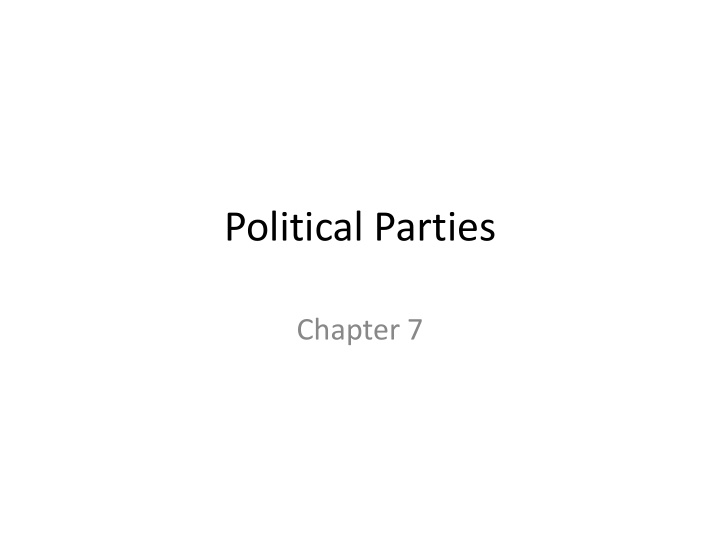



Political Parties Chapter 7
Nobody Wants to Party • Fun Fact: – A lot of Americans don’t really like our political parties
• What Washington is saying: – Political “factions” are inevitable, but dangerous. – Faction = Any group that puts its own interest above the best interest of everybody
Political Parties are “Teams” • Our government creates huge coordination problems 1. Elections a. Candidates for office need to get thousands to millions of votes to compete b. Again and again and again
2. In government • Getting anything done requires building majorities – Across BOTH chambers of Congress – And getting the President on board – AND between the states & federal gov’t
• As “teams”, Political parties: 1. Mobilize voters 2. Build stable alliances 3. Recruit new members / future elites
Political Parties are “Brands” • A lot of politics involves persuasion – Vote for me! – Support this legislation! – Agree with my plan! • Persuasion = marketing
• Branding is one of the key ideas – A brand is an “information shortcut” • The brand name itself is meant to give information about the product • “Brand identity”
• Remember from last chapter: – Part of the cost of voting is the information cost – Party leaders work to make sure the party’s name (the party label ) communicates information to voters
Features of the American Party System 1. Two-party competition – How can 305,000,000 Americans fit into just 2 political parties?
• Our electoral system only supports 2 political parties. • Single-member districts with plurality elections – SMDP system
SMDP • SMD means that we generally elect one officeholder at a time
Plurality Elections • Winning office usually does not require a majority vote
Duverger’s Law • SMDP systems lead to two-party competition – Why? • SMDP encourages strategic voting – Def: Voting for someone other than your first choice
• How it works: – Assume: 1. District with 100 voters 2. No political parties 3. Each voter chooses the candidate closest in ideology 4. 4 ideologies, 1 candidate from each 5. SMDP system
• Our population: Very Conservative 7 voters Conservative 44 voters Liberal 45 voters Very Liberal 4 voters
• 2 problems: 1. 55% of the population voted against the winner • BUT the plurality winner gets 100% of the available office – Disproportionate 2. If the “very conservatives” voted for the conservative candidate, she would have been unbeatable – 51% of the vote!
Consequences • SMDP systems encourage many voters to vote strategically – Specifically, those with strongly ideological views
• Most voters are pretty moderate – So, we get 2 big parties, 1 “center - left” and 1 “center - right”
2. “Big Tent” parties – The 2 parties must try to appeal to a wide range of voters – Big tent parties are coalitions of different interests, philosophies, and values
• BUT, these coalitions can be hard to keep together – Big tent parties are vulnerable to wedge issues
• Wedge issues are usually “temporary,” but… • Sometimes, an issue can “permanently” drive out an element of the party coalition – Realignment
American Party Coalitions • Just 40 years ago, the South had: – 0 Republican governors – 1 Republican Senator • Biggest shift in the last 50 years: – Realignment of white Southerners from strongly Democratic to largely Republican
• Why? – Since Reconstruction, the South was the main part of the Democratic coalition – In the 1930s, joined with northern workers & others in the “New Deal” coalition
• By the 1960s, the economy had long recovered – New issues began to emerge • As Democrats embraced civil rights laws, alienated many Southerners
Recommend
More recommend